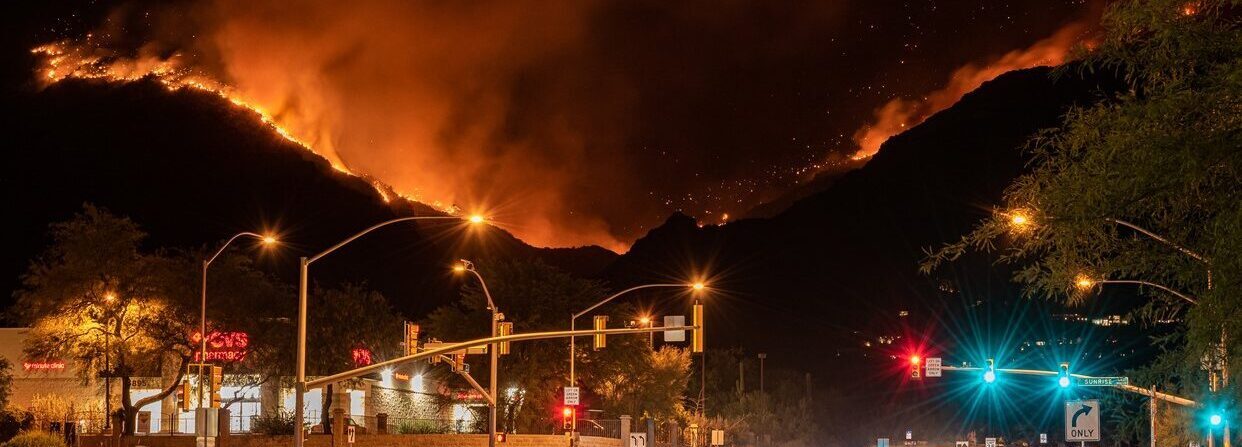The Urgency of Emergency Preparedness in Light of Extreme Weather Events
(August 29, 2023) In the first eight months of 2023, the United States confronted numerous climate challenges, indicating a pivotal moment for the nation and the planet. Hawaii faced the country’s deadliest wildfires in over a century, claiming more than 100 lives and leaving a staggering cost in their wake. In California, storms tested the state’s resilience through floods and mudslides, while in Phoenix, weeks of intense heat threatened its most vulnerable residents. In Vermont, rivers surged past their banks, while haze from Canadian wildfires degraded air quality in more than a dozen states. And all this as the year’s hurricane season is just getting underway.
These events demonstrate the escalating public health threats driven by climate change and the need for public health officials to play a role in addressing them. As global temperatures rise, we are seeing an uptick in heat-related illnesses and even fatalities, especially among individuals who are most at risk. Rising sea levels and intensified storms lead to flooding, which can contaminate drinking water and spread waterborne diseases. Meanwhile, wildfires, exacerbated by droughts and higher temperatures, compromise air quality, leading to a spike in respiratory problems, from asthma to chronic bronchitis. Furthermore, shifting climate patterns are expanding the range of many infectious disease vectors, like mosquitoes, exposing new populations to illnesses like malaria or dengue. The ripple effects of climate change touch nearly every aspect of public health, demanding policymakers’ attention and action.
Below is a partial round-up of the climate-related challenges that the country has already faced in 2023.
Wildfires in Hawaii. The U.S. grappled with its deadliest wildfires in over a century when fires that began as isolated brush incidents on the islands of Hawaii and Maui were intensified by the effects of Hurricane Dora and quickly escalated. Many public officials and residents were caught off guard by the size and rapid spread of the flames, leading to the tragic loss of more than 100 lives. Residents and officials now confront daunting reconstruction needs. Despite Hawaii’s reputation for lush greenery, its defenses have been compromised by significant reductions in rainfall. Diminished La Niña patterns, which traditionally bring cooler and wetter conditions to the region, have shifted, leading to warmer and drier trends. Furthermore, the proliferation of flammable invasive grasses, supplanting native vegetation, increases the fire risks.
Smoky skies. Canada, grappling with one of its harshest wildfire seasons, has seen tens of millions of acres of its landscape consumed by flames. The repercussions have been felt beyond its borders, with smoke significantly degrading air quality in several U.S. regions, including New England, the Southeast, and the Midwest. These conditions have led the Environmental Protection Agency to issue air quality alerts affecting millions of Americans. This sharp rise in fires is largely linked to the effects of global warming, which brings about drought and intense heat, rendering forests more vulnerable to blazes.
California storms. In early 2023, intense rains hit California. While they replenished reservoirs and snowpacks, they also caused flooding, mudslides, sinkholes, and tree damage that impacted infrastructure. A severe winter storm in late February trapped residents and led to the deployment of the California National Guard. Shortly after, another storm in the Sierra Nevada caused two fatalities and power disruptions. March saw the arrival of two bomb cyclones that brought tornadoes, heavy rain, and snow. These extreme weather events, exacerbated by climate change, underscore California’s oscillation between droughts and powerful storms. Such climatic shifts create atmospheric rivers that deliver heavy precipitation.
Notably, Southern California effectively weathered Tropical Storm Hilary’s record-setting rainfall in August, in part due to proactive measures like school closures and swift emergency response to road flooding and fallen trees. Despite the storm’s potential severity, no deaths were reported in major areas like Los Angeles and San Diego, highlighting the importance of preparedness.
Groundwater shortages in Arizona. Arizona officials sounded the alarm in June on groundwater shortages, signaling a potential halt to the rapid housing development in the Phoenix area, which is among the fastest-growing regions in the U.S. Although existing building permits will remain unaffected, the announcement underscores the urgent need for alternative water sources and conservation measures in future projects. Governor Katie Hobbs reassured that Arizona is not immediately running out of water, but shortages could have significant implications for the region’s future. Prolonged drought, combined with increasing water demand, have depleted the Colorado River and intensified water scarcity, posing a challenge for the region’s long-term sustainability.
Vermont flooding. In July, Vermont experienced severe flash and river flooding, leading to extensive damage to communities, roads, bridges, and causing significant property losses. This event broke several records, with Montpelier’s airport receiving the highest single-day rainfall since 1948. The destruction was comparable to the damage from Tropical Storm Irene in 2011. In terms of impact, the destruction from the 2011 and 2023 events was only surpassed by the Great Flood of November 1927, which took place before modern flood control measures were implemented in the state.
Hot water off the coast of Florida. A buoy off Florida’s coast this summer measured a sea surface temperature of 101.1 degrees Fahrenheit, potentially setting a new world record and far exceeding the typical range of 73F to 88F. This extreme heat, part of a concerning trend of warming waters in Florida, poses grave risks to marine life, ocean ecosystems, and human livelihoods. Increasing temperatures, intensified by phenomena like El Niño, could also boost the strength of tropical storms and hurricanes.
Extreme heat in Phoenix. Phoenix endured an unprecedented heatwave in July, with temperatures exceeding 110°F for 31 straight days, surpassing a 1974 record. This coincided with a global trend marking July the warmest month ever registered. Hospitals reported an uptick in heat-related cases, ranging from heat cramps to lethal heat strokes. The city’s medical examiner confirmed 25 heat-related deaths and is investigating many more. Critical infrastructure, such as air conditioners in shelters and medical buses, malfunctioned due to the extreme temperatures. With shelters at full capacity and public housing waitlists stretching for months, many unhoused residents were left without a haven from the oppressive temperatures.
President Biden announced initiatives in July to support communities suffering from extreme weather. To combat the rising heat, the primary weather-related cause of death in the U.S., he directed the Department of Labor (DOL) to issue its first-ever Hazard Alert concerning heat, with the intent to reinforce worker protections against heat-related dangers under federal law. This alert will educate employers on their responsibilities and help ensure that workers know their rights. The DOL has committed to intensifying its enforcement against heat-safety violations, focusing especially on high-risk sectors like construction and agriculture. Meanwhile, the National Oceanic and Atmospheric Administration is allocating up to $7 million to enhance weather forecasting in collaboration with educational institutions, aiming to boost preparedness for extreme weather events. Additionally, the Department of the Interior is in the process of investing $152 million to bolster water storage and climate resilience in California, Colorado, and Washington, addressing the challenges of prolonged drought and ensuring access to clean drinking water.
These efforts build on past actions by the Biden-Harris Administration, such as channeling billions of dollars via the Department of Housing and Urban Development for energy-efficient building upgrades and the establishment of cooling centers. Additionally, in collaboration with Congress, it earmarked over $50 billion from the Infrastructure Investment and Jobs Act to bolster climate resilience throughout the nation.
As Trust for America’s Health (TFAH) has previously highlighted, preparing for weather-related events is a critical element of public health emergency preparedness. Collaboration between public health officials and partners—such as federal, state, local, tribal, and territorial agencies, emergency response teams, community-based organizations, and hospitals—is fundamental. Working together, they can pave the way for better preparation and response strategies, utilizing data to predict and lessen potential health impacts. Proactive measures are crucial in safeguarding communities from these escalating threats. For example, the nation needs significant investment in climate-resilient infrastructure — from storm-resistant housing to updated water management systems. To protect people from extreme heat, communities must prioritize public education on heat risks, establish cooling centers, and adapt urban infrastructure to reduce heat retention. It’s crucial to acknowledge that socioeconomic and health inequities have historically worsened the impact of extreme heat on communities of color, making targeted interventions in these communities even more essential. Strengthening early warning systems and ensuring equitable access to hydration and emergency healthcare resources are vital steps. It’s also imperative to bolster our health systems’ readiness to respond to the increasing burden of climate-related illnesses. This includes enhancing disease surveillance and training healthcare professionals to recognize and treat emerging health threats, especially in communities that face disproportionate risks.
In line with a comprehensive public health approach, the Building Resilience Against Climate Effects (BRACE) framework from the Centers for Disease Control and Prevention (CDC) offers a vital tool. This strategic framework empowers officials to develop and implement health adaptation plans tailored to their specific climate change challenges. By guiding health departments through a five-step process — from forecasting climate impacts and assessing vulnerabilities to developing and implementing a comprehensive adaptation plan — the BRACE framework ensures a data-driven response that accounts for local nuances. Recognizing the disparate effects of climate change on various populations, this approach emphasizes not just broad community safeguards but also targeted interventions to protect those most at risk. To more adequately support these crucial initiatives, TFAH recommends funding the CDC’s Climate and Health Program at a level of $110 million for Fiscal Year 2024. This program collaborates with state, local, tribal, and territorial health agencies to address climate change impacts, primarily utilizing the BRACE framework. Additionally, it offers resources, funding, and support through various initiatives to enhance community preparedness and communication regarding climate-related health risks. As communities continue to witness the tangible effects of a changing climate, leaning into systematic and strategic frameworks like BRACE becomes paramount. The synthesis of proactive planning, community-specific interventions, and overarching public health strategies helps bring about a resilient and equitable response.
Acting to protect health and well-being by improving our systems’ readiness and enhancing protective measures—commonly termed climate adaptation—is a critical public health priority. Climate mitigation refers to efforts to reduce or prevent greenhouse gas emissions or to remove them from the atmosphere, aiming to curb future global warming. Both the Intergovernmental Panel on Climate Change, a scientific body under the auspices of the United Nations that assesses climate change information, and the United States Global Change Research Program, which coordinates U.S. research on global environmental changes and evaluates climate change impacts, emphasize that mitigation and adaptation are complementary strategies crucial for reducing the human impacts of climate change.





